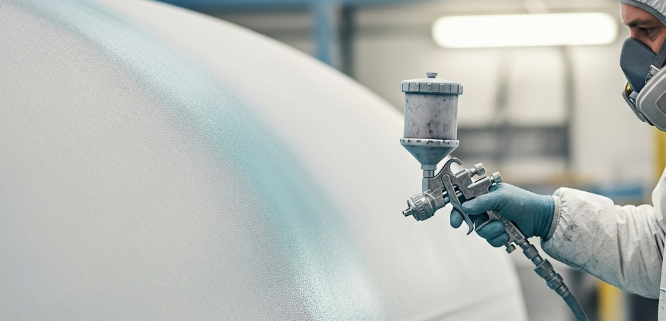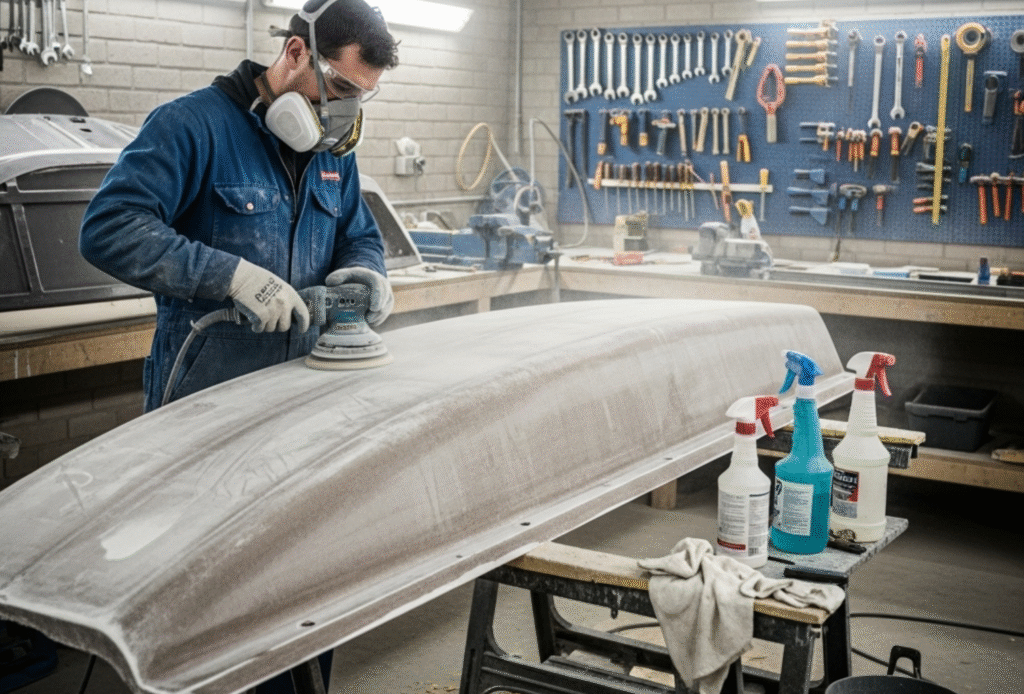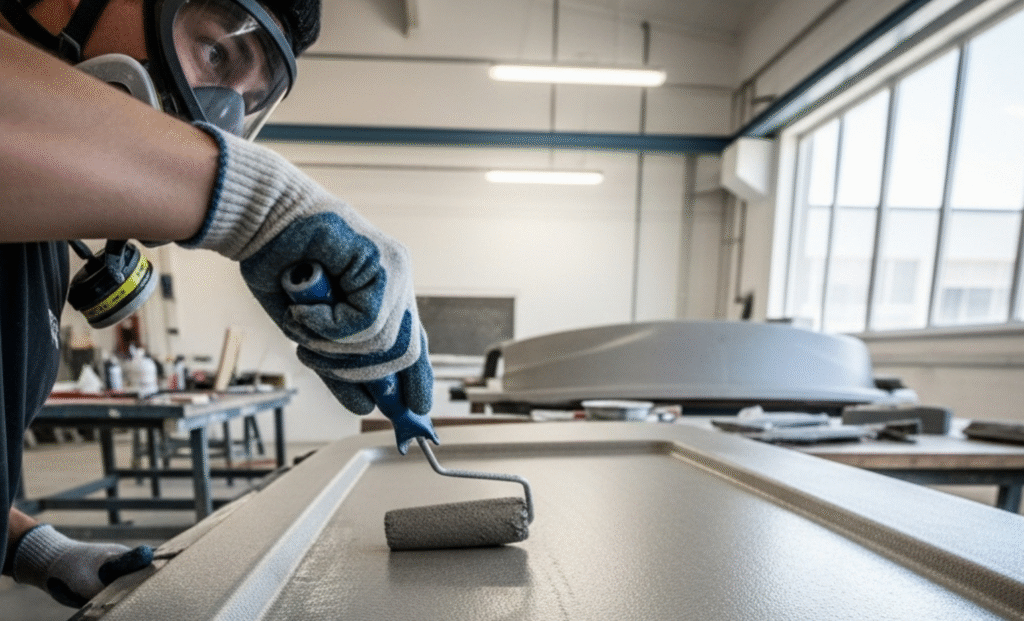Fiber Reinforced Plastic (FRP) is light, strong, and resistant to corrosion. It is widely used in ships, buildings, transport, and industry.
But FRP surfaces are not perfect. Sunlight, water, and chemicals can still damage them over time.
FRP Paint helps solve these problems. It protects the surface, improves appearance, and makes FRP last longer.
This guide explains FRP Paint in simple detail—its types, how it is applied, how it is tested, where it is used, and what trends are shaping its future.
What Is FRP and Why Paint It?
FRP is made from resin mixed with glass fibers. The resin can be polyester, epoxy, or vinyl ester. The glass fibers add strength and stiffness.
Even though FRP is strong, the surface is smooth. Paint may not stick well without preparation. Sunlight can make FRP fade or turn yellow. Chemicals can cause it to age. Moisture can lead to surface breakdown.
Painting FRP solves these problems. Coatings improve adhesion, protect against UV, add chemical resistance, and keep the surface from wearing out. Most importantly, paint extends the service life of FRP and reduces costs for repair or replacement.

Types of FRP Paint
Epoxy Coatings
Epoxy coatings are strong and resist chemicals well. They also protect against water and provide good hardness. These paints are common in chemical plants, storage tanks, and floors. Their weakness is poor UV resistance. Outdoors, they can yellow or chalk, so a polyurethane topcoat is often added.
Polyurethane Paints
Polyurethane paints perform well against UV and weather. They keep gloss and color for a long time, making them ideal for facades, decks, and outdoor FRP parts. However, they are more expensive and need strict control of humidity and temperature during application.
Vinyl Ester Coatings
Vinyl ester coatings offer excellent chemical and heat resistance. They outperform polyester resins in harsh environments and are often used in chemical tanks and pipelines. The main drawback is their higher cost and strict curing requirements.
Acrylic and Water-Based Paints
Acrylic and water-based paints are eco-friendly and easy to apply. They come in many colors and are often used indoors, such as in bathrooms, kitchens, and hospitals. Still, they lack the durability and chemical resistance of epoxy or polyurethane, so they are not suitable for demanding conditions.
Summary
Each paint type has advantages and limits. The best choice depends on where the FRP will be used and the performance that is required.
The Painting Process

Painting FRP is more than just brushing on color. It is a step-by-step process.
The first step is surface preparation. FRP surfaces are often smooth and may have mold release agents or dirt. These must be cleaned off. Then the surface is sanded to create texture so the paint will stick better.
Next comes the primer. A primer forms a strong bond with FRP and helps the topcoat adhere. Epoxy primers are common because they also add protection against corrosion.
After that, the topcoat is applied. It can be sprayed, brushed, or rolled. For large or complex parts, spraying is best. Thin coats are applied several times instead of one thick coat. This avoids bubbles and cracking.
Finally, the coating must cure and dry under proper conditions. If the air is too humid or cold, the paint may not cure well. Outdoor painting should not be done in direct sun or strong wind.
Once in service, FRP coatings need regular maintenance. Surfaces should be inspected. Any cracks or damage must be repaired quickly. This stops water or chemicals from reaching the FRP beneath.
Performance and Testing
Good FRP coatings are tested to meet certain standards.
Adhesion strength is measured with tests like ASTM D4541 or ISO 4624. High-quality coatings bond tightly to the surface.
Weathering resistance is tested with accelerated aging. Coatings are exposed to UV and moisture in controlled chambers. A good coating keeps its color and gloss.
Chemical resistance is checked by putting coated samples in acids, alkalis, salts, or solvents. The coating should not soften, blister, or change color.
Abrasion and impact resistance show how coatings hold up against wear and mechanical stress. ASTM D2794 and ISO 6272 are common tests.
In some industries, coatings must also meet fire safety standards, such as UL94 or ASTM E84. This is important in transport and building materials.
Applications of FRP Paint
Marine and Shipbuilding
FRP Paint is widely used on boats, yachts, and ship decks. The coating protects against salt spray, moisture, and UV damage, helping vessels stay durable in harsh marine environments.
Construction and Architecture
In buildings, FRP coatings are applied to facades, roofing, and decorative panels. They keep surfaces weather-resistant while maintaining a clean and attractive appearance.
Chemical and Wastewater Plants
Coatings play a critical role in protecting FRP tanks, pipes, and covers. Epoxy and vinyl ester systems resist strong acids, alkalis, and other corrosive chemicals in industrial plants.
Transportation
FRP Paint is applied to automotive parts, railway interiors, and aerospace components. It improves durability, provides wear resistance, and meets fire safety requirements in transport systems.
Public and Healthcare Facilities
In kitchens, bathrooms, and hospitals, FRP coatings create smooth, hygienic surfaces. They are easy to clean and resist mold, water, and frequent washing.
Advantages and Limitations
FRP Paint has many benefits. It improves the appearance of FRP. It adds resistance to UV, water, and chemicals. It helps components last longer and reduces maintenance costs.
But coatings also have limits. They need careful surface preparation and correct application. Without these, the paint may peel or fail early. High-performance paints are expensive. And all coatings need regular inspection and upkeep.

Future Trends
The future of FRP coatings points toward better performance and sustainability.
Low-VOC and waterborne paints are becoming more common. They are safer for workers and better for the environment. Functional coatings are also rising in demand, such as antimicrobial, anti-fouling, self-cleaning, and anti-static types.
High-performance coatings that withstand extreme UV, heat, and temperature swings are being developed for outdoor use. Smart coatings are an exciting area too. These paints can change color or give signals when they are aging, making maintenance easier.
Best Practices
To get the best results from FRP Paint, the right paint must be chosen for the environment. Epoxy or vinyl ester is best for chemical exposure. Polyurethane is better for outdoor use.
Surface preparation is critical. Skipping cleaning or sanding will cause failure. Thin coats should be applied in several layers, not one thick coat. And coatings should always be checked and repaired over time.
Conclusion
FRP Paint is not only about decoration. It is a vital layer of protection for FRP components. With the right paint, proper application, and regular maintenance, FRP can stay strong and attractive for many years, even in harsh environments.
For engineers, manufacturers, and end users, understanding FRP Paint is the key to unlocking the full potential of this versatile material.


